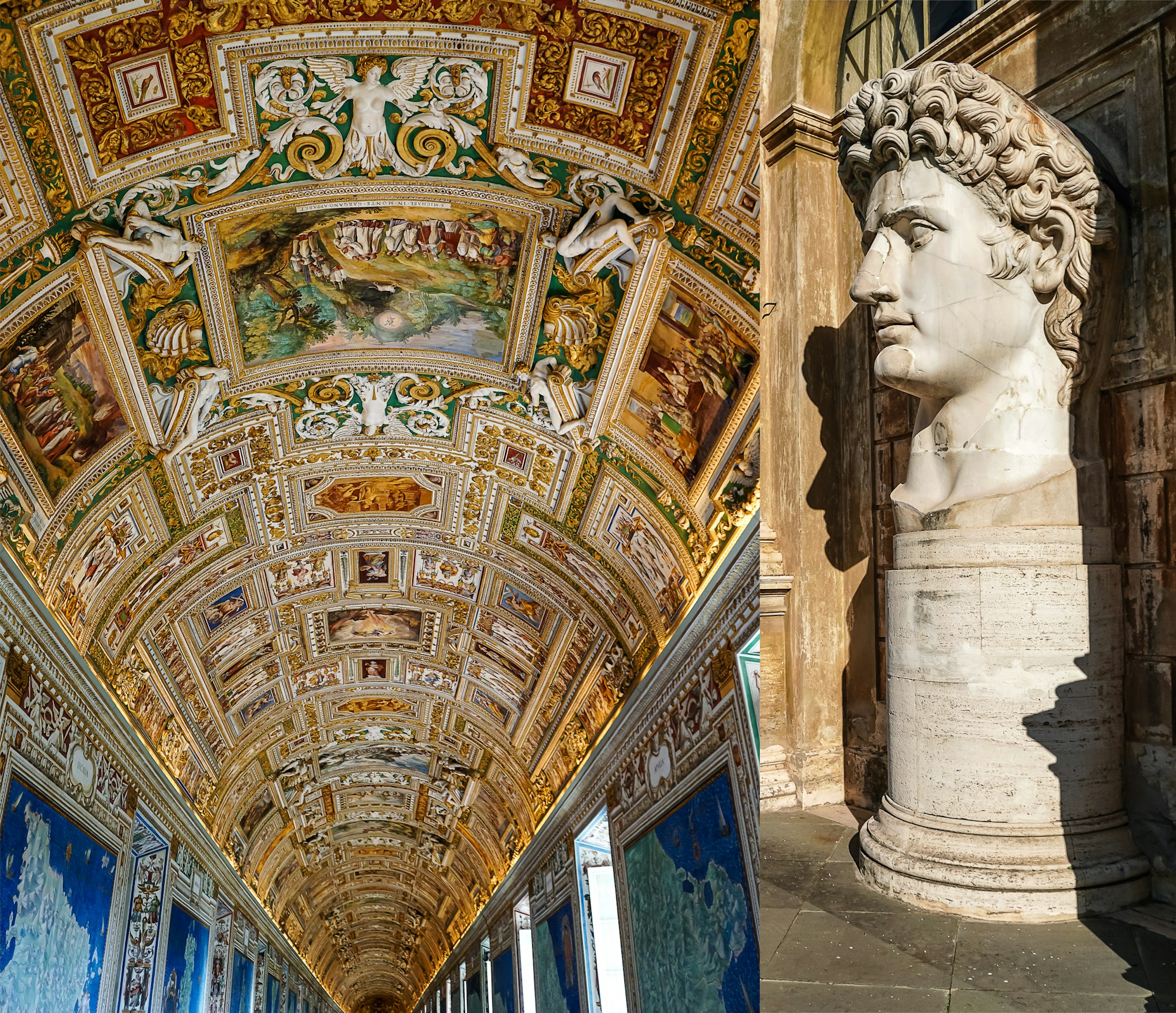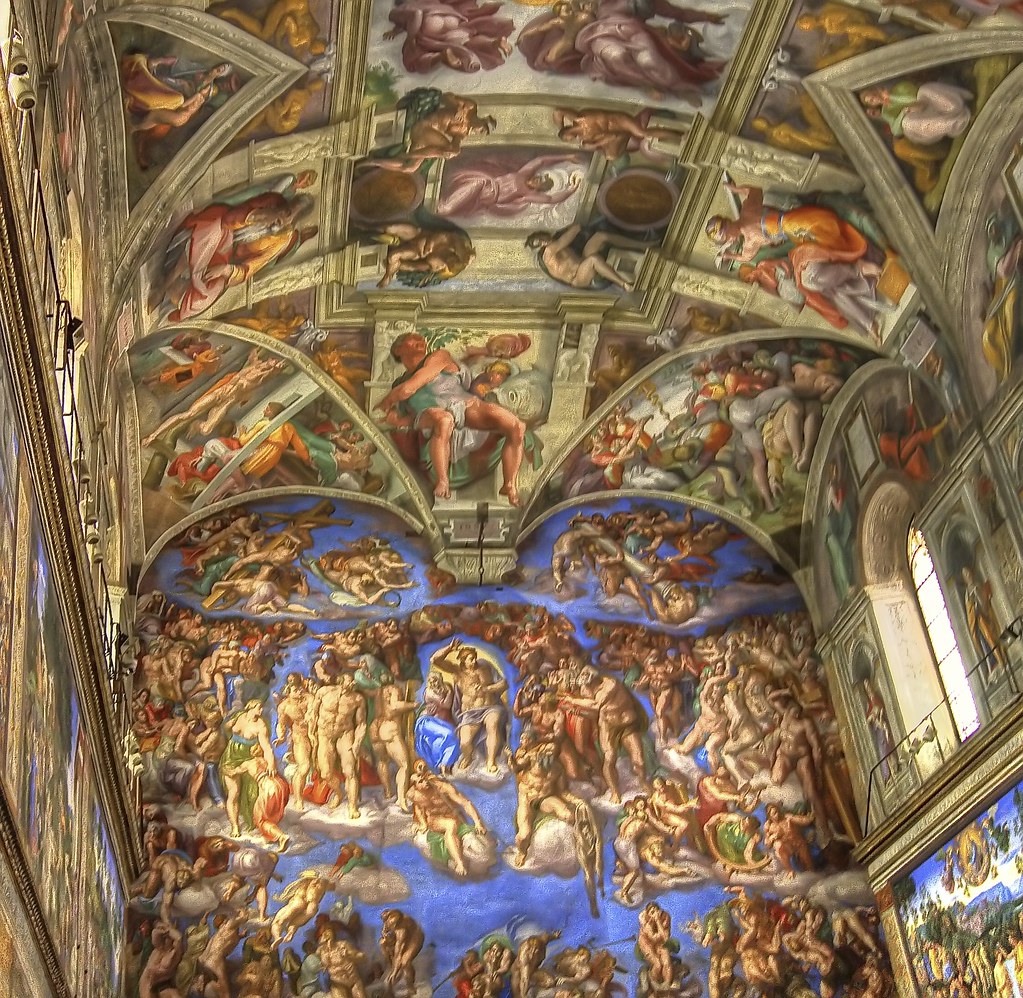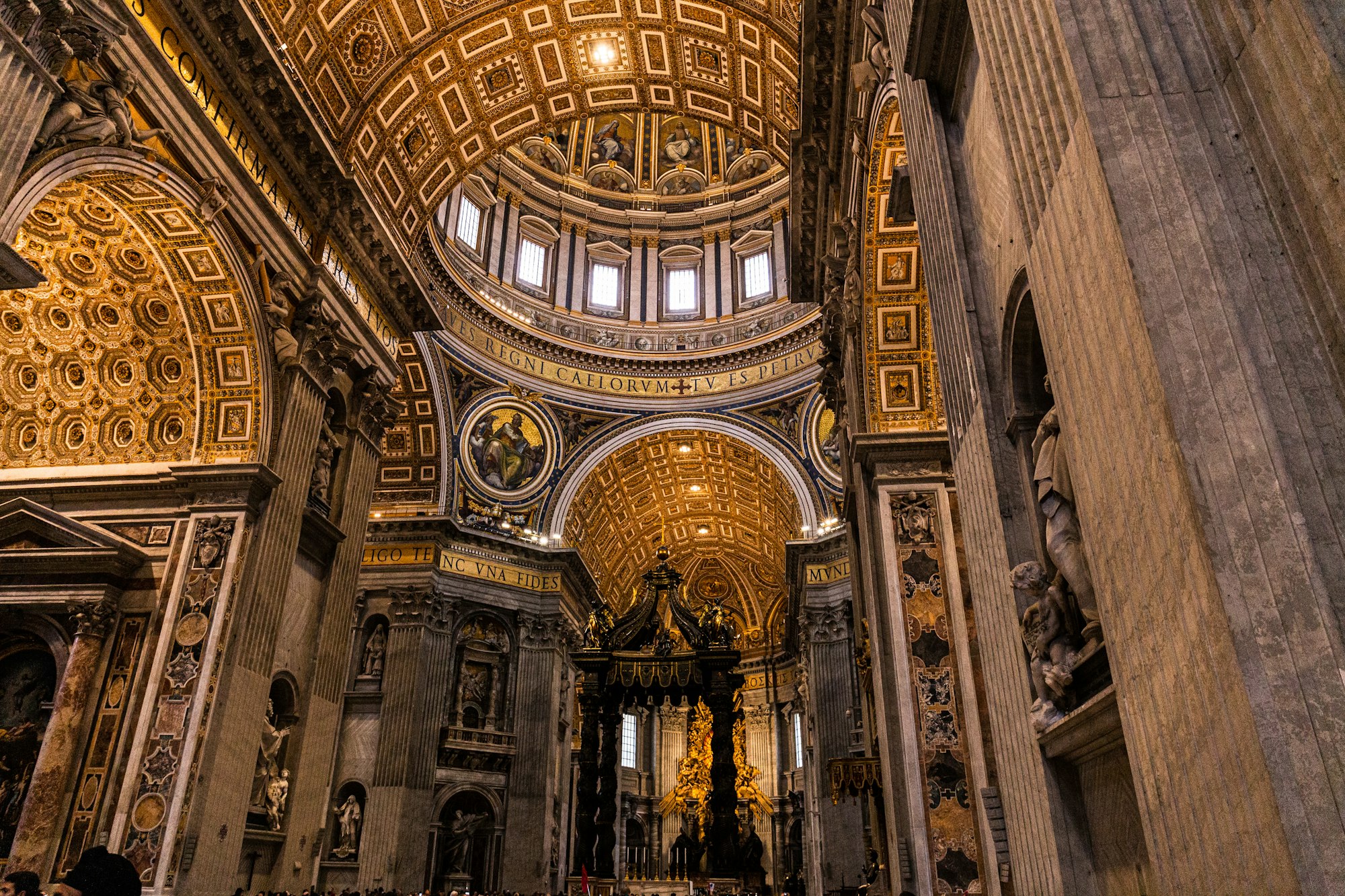In the heart of the City of Vaticanshrouded in an aura of sacredness and magnificence, stand the Vatican Museums, one of the most important and visited museum complexes in the world. This article will guide you through the hidden wonders and masterpieces that have made the Vatican Museums an unmissable landmark for art lovers, believers, and the curious from all over the world.
La history of Vatican Museums is a fascinating journey through the centuries, beginning in 16th century with the vision of Pope Julius II. This pontiff, known for his patronage and passion for art, decided to exhibit a collection of antique sculptures in the courtyard of the Belvedere, thus starting what was to become one of the largest museum complexes in the world. This choice was not accidental but reflected the Church's desire to reassert its power and culture in a period marked by profound changes, such as the Protestant Reformation.
Over the centuries, the collection was greatly enriched thanks to the contributions of various popes and collectors who added pieces of inestimable valuetransforming the Vatican Museums into a veritable treasure trove of human civilisation. The works range from theclassical antiquitywith Greek and Roman sculptures narrating the ideals of beauty and perfection, to theart Renaissancewitness to a time when man and his creative capacity became the centre of the universe.

But the Vatican Museums are not only a place to admire ancient and Renaissance art. Their collections also include important finds Egyptianswhich allow us to explore the ancient civilisations of the Nile, and works by themodern agedemonstrating how the Church has continued to take an interest in and promote the arts well beyond the Renaissance. This diversity of collections makes the Vatican Museums a unique place where the history of art and human culture for more than 2000 years can be traversed.
The fascination of the Vatican Museums lies not only in the works on display but also in their ability to tell the story of how they have been collected, conserved and admired over the centuries. Every room, every work, every sculpture has its own story, intertwined with that of the popes, artists, patrons and visitors who have passed through these corridors over the centuries. The history of the Vatican Museums is therefore a living history, which continues to evolve and be enriched every day.
Visit the Vatican Museums is not simply a matter of admiring works of art; it is an experience that touches the soul, offering a profound reflection on the history of humanity, the Christian faith and the role of art in our lives. The sacred art, the masterpieces, the frescoes that adorn the walls and ceilings of the Vatican Museums speak a universal language that transcends cultural and temporal barriers.
La Sistine Chapelwith Michelangelo's frescoes, is perhaps the most eminent example of how art can elevate itself as a vehicle for spiritual and theological messages. Observing the Last Judgement or the creation of Adam, forces us to reflect on our place in the cosmos, on the questions of life, death and salvation that have always questioned man.

Similarly, the Raphael Rooms offer an insight into Renaissance man, his faith, his science, his art, and how these dimensions can coexist and enrich each other. Every room in the Vatican Museums, from Map Gallery at Art Galleryis a chapter in this great narrative that interweaves faith, art and humanity.
But visiting the Vatican Museums is also an opportunity to reflect on our cultural and spiritual heritage. In an age of rapid change and historical amnesia, the art preserved in the Museums reminds us where we come from, what great minds have shaped our cultural and spiritual heritage, and what profound questions they have tried to answer through their art.
In conclusion, the Vatican Museums are not just a museum to visit, but a place to live, an experience that enriches not only our knowledge but also our spirit. They are a bridge between the past and the present, an invitation to reflect on great questions in the company of some of the greatest artists humanity has ever known.
At the centre of the artistic universe of the Vatican Museums, the Sistine Chapel represents not only the centre of the spiritual and cultural life of Vatican City, but is also a universal symbol of art that transcends the barriers of time and space. This chapel, frescoed by some of the most illustrious masters of the Renaissance such as Michelangelo Buonarroti, Sandro Botticelli, e Peter Peruginois a triumph of Renaissance art that tells biblical and mythological stories through a visual language of immeasurable beauty.
The Chapel's vault, frescoed by Michelangelo between 1508 and 1512, is a work of epic proportions depicting scenes from Genesis, from the Creation to Noah's Drunkenness. At the centre of this visual narrative, the touch between God's finger and Adam's finger has become one of the most powerful symbols of humanity. But it is the Last Judgementpainted by Michelangelo between 1536 and 1541 on the altar wall, captures the ultimate essence of the master's artistic and theological vision, offering a breathtaking representation of the final destiny of souls.
Another treasure that enriches the artistic heritage of the Vatican Museums are the Raphael Roomsoriginally conceived as papal flats. These rooms, decorated by Raphael Sanzio and his pupils, are masterpieces of balance, harmony and beauty, where the sacred and the profane dialogue incessantly. The frescoes narrate biblical stories, historical events and mythological themes, reflecting the complex cultural and spiritual texture of the Renaissance.

The Stanza della Segnatura contains some of Raphael's most famous frescoes, including 'The School of Athens', which represents the culmination of the Renaissance ideal of a harmonious symbiosis between philosophical knowledge and artistic beauty. Through these works, Raphael not only demonstrates his technical mastery and profound erudition, but also invites visitors to reflect on the great questions of existence, the role of man in the universe and the possibility of a dialogue between different spheres of knowledge.
La Vatican Art Gallery is a must-visit destination for anyone wishing to immerse themselves in the history of Western art. With works by masters such as Caravaggio, Leonardo da Vinci, e Giotto, the Picture Gallery offers an exciting journey through the centuries, from medieval painting to the 20th century. Each room of the Picture Gallery is like a chapter in a book, recounting the evolution of artistic thought and technique through the ages.
The collection of the Picture Gallery is particularly rich in its assortment of Renaissance and Baroque works, with pieces ranging from delicate devotional paintings to large narrative compositions. Works such as Caravaggio's 'The Deposition' or Leonardo's 'Saint Jerome in the Study' offer visitors the opportunity not only to admire the aesthetic beauty and technical mastery of the great artists, but also to immerse themselves in the profound spiritual, philosophical and human questions that these works raise.
To walk through the rooms of the Vatican Art Gallery is to embark on a journey through timean experience that enriches the spirit and stimulates the mind, making the Vatican Museums not just a place for the preservation of art, but a veritable workshop where the past dialogues with the present, inviting reflection and inspiration.

I Vatican Museums are not only one of the largest and most important museum complexes in the world but also one of the most visited, with millions of people passing through its doors every year. This immense popularity can result in long queues and waits, especially during the high season. The first and most crucial advice for anyone wishing to visit the museums is, therefore, to book your ticket online in advance. This simple step not only allows you to secure access, but also to skip the long queues at the entrance, optimising the time available to explore the collections.
Booking in advance is more than a convenience; it is a way to ensure a more intimate and personal experience with the works of art. Visiting the Vatican Museums without the pressure of crowds allows you to take the time to admire the details, reflect on the art and truly absorb the magnificence of the place. Moreover, planning in advance also means having the possibility to choose between different visit options, such as early morning entry or special evening visits, which offer an even more atmospheric and peaceful atmosphere.
Being an integral part of the Vatican, the Museums are not only a place of inestimable artistic value, but also a site of great spiritual and religious significance. Consequently, visitors are asked to adopt a respectful clothing. This means clothes that cover shoulders and knees, a requirement not only for women but also for men. Long trousers, skirts of adequate length and shirts that cover the shoulders are therefore mandatory.
Respecting this dress code is not just a matter of etiquette; it is a way of showing respect towards the sacred place one is visiting and towards other visitors. This attitude of respect helps to create an atmosphere more conducive to reflection and appreciation of art, in keeping with the spirit of the Vatican Museums.
While exploring the Vatican Museums on your own can be a fascinating adventure, opting for a guided tour can significantly enrich the experience. Experienced guides not only lead visitors through the most famous works and less-travelled routes, but also reveal hidden stories, easily overlooked details and anecdotes that make each work even more vivid and interesting. This option is particularly valuable for those who wish to fully understand the history, context and significance of the museums' immense collections.
Guided tours are available in several languages and can be tailored to the specific interests of visitors, whether they are interested in ancient art, Renaissance or modern art. In addition, participating in a guided tour also means having the opportunity to ask questions and interact with an expert, making a visit to the Vatican Museums a more dynamic and participative experience.
Visit the Vatican Museums is more than just a tourist activity; it is a journey through beauty, history and spirituality that deeply touches anyone who undertakes it. Every hall, every corridor, every work of art tells a part of our collective history, offering insights into what unites us as humanity.
To make the most of this unique opportunity, it is essential to book in advancewear a appropriate clothing and consider a guided tour to discover the stories hidden behind the magnificent works on display. With these insights, a visit to the Vatican Museums will turn into an unforgettable experience that will leave an indelible mark on the heart and mind of every visitor.
Preparing adequately for this adventure means being able to fully enjoy the majesty and sacredness of one of the most extraordinary museums in the world. Enjoy your visit to the Vatican Museums!
We are a young Web Agency with more than 10 years of experience, we love travelling and discovering new places, that is why we write every day on Italia Delight our travel site.

Italia Delight is your definitive guide to Italian restaurants, offering a comprehensive directory and web marketing services to enhance every dining experience. Discover, taste and connect with Italian tradition.
To provide the best experiences, we and our partners use technologies like cookies to store and/or access device information. Consenting to these technologies will allow us and our partners to process personal data such as browsing behavior or unique IDs on this site and show (non-) personalized ads. Not consenting or withdrawing consent, may adversely affect certain features and functions.
Click below to consent to the above or make granular choices. Your choices will be applied to this site only. You can change your settings at any time, including withdrawing your consent, by using the toggles on the Cookie Policy, or by clicking on the manage consent button at the bottom of the screen.